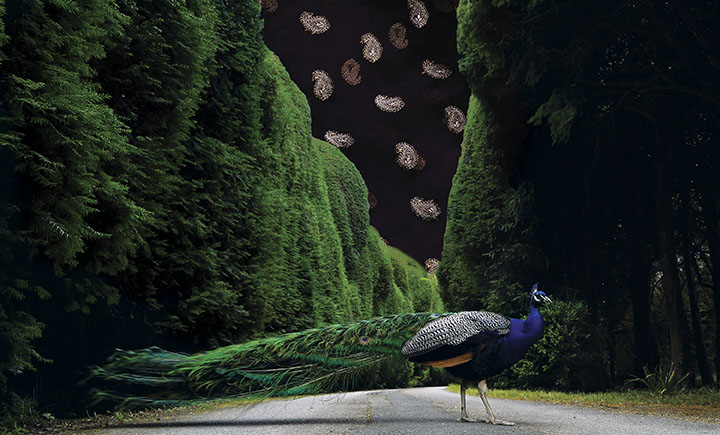 Photo: Leila Sujir combines video of lost-looking but regal peacocks with floating animations in her stereoscopic 3D video projection, “Peacocks Dream.”
Photo: Leila Sujir combines video of lost-looking but regal peacocks with floating animations in her stereoscopic 3D video projection, “Peacocks Dream.”
Four of FotoFest’s dazzling displays focus on Indian portraiture
Technically, as director Steven Evans explained, “It’s not really about India. It’s about these artists of Indian origin and what their concerns are.”
Through that lens, he and curator Sunil Gupta also are showing that India is not a monolithic place. “It’s got 140 official languages, with 600 languages spoken; multiple religions and ethnicities; concerns of philosophy, language, indigenous people, environment and a new queer sensibility emerging,” Evans said.
Viewers may be dazzled, or dazed, by the busy mix of images that unfold across four venues.
A few categories emerge through what appears to be a scattershot organization: Documentary work and portraiture (especially self-portraiture that employs elaborate impersonations to explore identity) are especially strong.
Most of the 47 featured artists live and work in India. That context matters.
Gupta contrasts India’s contemporary photography scene with that of China, which has 60 schools, a thriving publishing industry and numerous art fairs. In India, art photography is still the activity of the English-speaking elite, he said.
FotoFest’s abundance of documentary photography from numerous regions reflects artists’ familiarity with India’s documentary filmmaking tradition, he said. “It’s not because they know Walker Evans.”
But they do know technology. Like others around the world, India’s contemporary artists have embraced new technology because it’s accessible, cheap to produce and gives them “a certain kind of global credibility,” Gupta said.
About a third of this biennial features new media installations — the most ever — although it doesn’t feel that way because the rooms devoted to projected work are sprinkled across the venues.
Four installations — three by female artists — have stayed with me for their evocative storytelling. There’s one more week to see those at the three locations near Fotofest headquarters; Asia Society Texas Center’s smaller portion is up through late July.
‘Peacocks Dream’
During the opening reception in March, Leila Sujir’s “Peacocks Dream” turned an alcove of the Silver Street Studios building into a spectacle. I fell into its spell on a quieter day, when the nearly 16-minute stereoscopic 3-D (SD3) video, or anaglyph, was projected onto just one wall and I could don 3-D glasses, sit on a bench and hear the audio component.
Regal peacocks amble through a garden of mazes at what appears to be an ancient estate in England, looking out of place with their exotic, brilliant plumage, as viewers hear the measured reading of letters between family members who are worlds apart. Sujir layers funny animated peacocks, floating paisley designs and a fanciful border onto the photography, touches of levity that balance the melancholy tone.
She lives in Montreal. The letters are from her family’s archive, written from her paternal grandfather in Mangalore, India, to her father, who died young, in his mid-30s, in a plane crash in Canada. For years, she feared that her father’s story would become her own because his journeys placed him in precarious positions, too far away from home. Her narrative is abstract enough that “Peacocks Dream” expresses a universal sense of disorientation and loss.
SD3 dates from the mid-1800s but has evolved. Anaglyphs combine superimposed imagery and colored filters. Sujir has experimented with projection mapping, which places SD3 video space into the built environment — to create installations — for more than a decade. She appreciates the “haptic sense of space” it creates to help convey themes of migration that have intrigued her for 30 years. “SD3 video spaces are elastic and dream-like places, ephemeral, yet capable of extending a sensation of volume, physicality, and presence to the viewer,” she writes.
Watching “Peacocks Dream” made me wish I could see Sujir’s entire “Elastic City Spacey” series.
